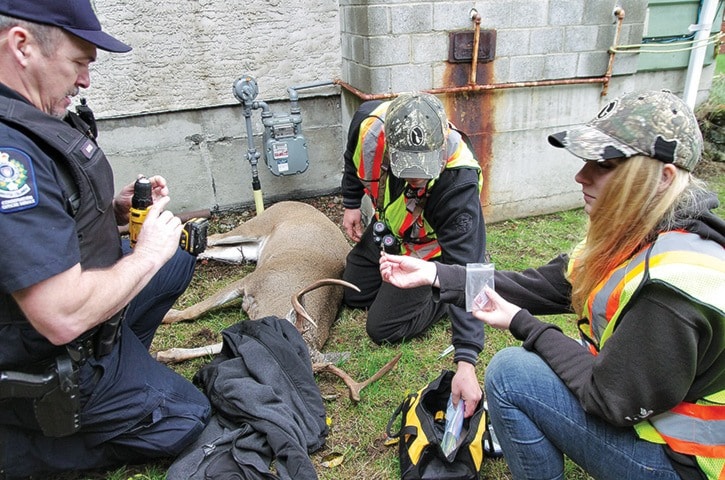It’s considered unsportsmanlike for hunters to bait their quarry, but 'baiting' deer is the latest arrow added to conservation officers’ quiver of methods they’re using to combat poachers.
Poaching of Nanaimo’s urban deer population is illegal, cruel to the animals and dangerous for bystanders when poachers shoot arrows or cross bolts in public parks and wooded areas.
The Bait Deer program – similar to the Bait Car program used by police to catch car thieves – is proving to be an effective deterrent to poachers, but instead of hidden cameras in a vehicle, conservation officers tranquilize deer and implant them with trackable electronic tags.
“It lets us track the deer. We have some hidden stuff in the deer that we’re dealing with, so that if someone does poach it I can find out later and prove where that deer came from,” said Stuart Bates, conservation officer. “Some of them have obvious collars and those collars give us GPS tracking. If one of those deer is doing 80K down the highway someone’s got some explaining to do.”
The GPS collars also let biologists with the program retrieve data about the animals’ territories and movements. Bates won’t say how many deer have been tagged so far, but enough have been to reveal previously unknown information about their ranges.
“It works two-fold. It works for me for catching poachers and it works for the biologists because they get some great data,” Bates said. “We didn’t realize how small their areas were. Most deer that we have GPS tracking on have not gone more than half a kilometre.”
Small ranges means where a poached deer came from can be traced through its DNA. If someone claims a deer was taken in a location 20 kilometres distant from where the animal’s DNA says it should have been, investigators will know that person isn’t being truthful.
“Wildlife medicine is a lot more in the lab, sort of dead animal work, so this is exciting. This is different,” said Blythe Sola, a veterinary student intern from the University of Calgary.
The program has been an effective deterrent. Bates said, prior to program, the Conservation Officer Service would receive up to 30 reports of poaching annually from Departure Bay and Hammond Bay.
“It could be a dead deer with an arrow hole in it or a bloody arrow. We even found one where we found a bloody arrow in a school field at nine o’clock on a Monday morning,” Bates. “Last year we didn’t have any calls.”
There have been possibly two poaching incidents – one in Nanaimo, one in Nanoose – so far this year.
Sola administered tranquilizer antidote and examined the health of a buck, darted and tagged in Hammond Bay on Thursday.
Raising awareness about the program helps with deterrence and public safety, should someone decide to kill and eat a deer in Nanaimo that was recently tranquilized.
“There is nothing to tell somebody, in an hour, that deer is full of drugs,” Bates said. “We wouldn’t want people eating it.”
